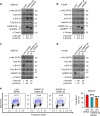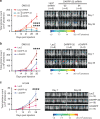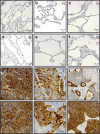ASCL1-regulated DARPP-32 and t-DARPP stimulate small cell lung cancer growth and neuroendocrine tumour cell proliferation
- PMID: 32499571
- PMCID: PMC7463034
- DOI: 10.1038/s41416-020-0923-6
ASCL1-regulated DARPP-32 and t-DARPP stimulate small cell lung cancer growth and neuroendocrine tumour cell proliferation
Abstract
Background: Small cell lung cancer (SCLC) is the most aggressive form of lung cancer, and new molecular insights are necessary for prognostic and therapeutic advances.
Methods: Dopamine and cAMP-regulated phosphoprotein, Mr 32000 (DARPP-32) and its N-terminally truncated splice variant, t-DARPP, were stably overexpressed or ablated in human DMS-53 and H1048 SCLC cells. Functional assays and immunoblotting were used to assess how DARPP-32 isoforms regulate SCLC cell growth, proliferation, and apoptosis. DARPP-32-modulated SCLC cells were orthotopically injected into the lungs of SCID mice to evaluate how DARPP-32 and t-DARPP regulate neuroendocrine tumour growth. Immunostaining for DARPP-32 proteins was performed in SCLC patient-derived specimens. Bioinformatics analysis and subsequent transcription assays were used to determine the mechanistic basis of DARPP-32-regulated SCLC growth.
Results: We demonstrate in mice that DARPP-32 and t-DARPP promote SCLC growth through increased Akt/Erk-mediated proliferation and anti-apoptotic signalling. DARPP-32 isoforms are overexpressed in SCLC patient-derived tumour tissue, but undetectable in physiologically normal lung. Achaete-scute homologue 1 (ASCL1) transcriptionally activates DARPP-32 isoforms in human SCLC cells.
Conclusions: We reveal new regulatory mechanisms of SCLC oncogenesis that suggest DARPP-32 isoforms may represent a negative prognostic indicator for SCLC and serve as a potential target for the development of new therapies.
Conflict of interest statement
The authors declare no competing interests.
Figures






Similar articles
-
Ascl1-induced Wnt11 regulates neuroendocrine differentiation, cell proliferation, and E-cadherin expression in small-cell lung cancer and Wnt11 regulates small-cell lung cancer biology.Lab Invest. 2019 Nov;99(11):1622-1635. doi: 10.1038/s41374-019-0277-y. Epub 2019 Jun 23. Lab Invest. 2019. PMID: 31231131
-
Significance of achaete-scute complex homologue 1 (ASCL1) in pulmonary neuroendocrine carcinomas; RNA sequence analyses using small cell lung cancer cells and Ascl1-induced pulmonary neuroendocrine carcinoma cells.Histochem Cell Biol. 2020 Jun;153(6):443-456. doi: 10.1007/s00418-020-01863-z. Epub 2020 Mar 13. Histochem Cell Biol. 2020. PMID: 32170367
-
Comparative analysis of TTF-1 binding DNA regions in small-cell lung cancer and non-small-cell lung cancer.Mol Oncol. 2020 Feb;14(2):277-293. doi: 10.1002/1878-0261.12608. Epub 2019 Dec 15. Mol Oncol. 2020. PMID: 31782890 Free PMC article.
-
Small cell lung cancer, an epithelial to mesenchymal transition (EMT)-like cancer: significance of inactive Notch signaling and expression of achaete-scute complex homologue 1.Hum Cell. 2017 Jan;30(1):1-10. doi: 10.1007/s13577-016-0149-3. Epub 2016 Oct 26. Hum Cell. 2017. PMID: 27785690 Review.
-
Molecular pathology of small cell lung cancer: Overview from studies on neuroendocrine differentiation regulated by ASCL1 and Notch signaling.Pathol Int. 2024 May;74(5):239-251. doi: 10.1111/pin.13426. Epub 2024 Apr 12. Pathol Int. 2024. PMID: 38607250 Review.
Cited by
-
NDR1 activates CD47 transcription by increasing protein stability and nuclear location of ASCL1 to enhance cancer stem cell properties and evasion of phagocytosis in small cell lung cancer.Med Oncol. 2022 Oct 12;39(12):254. doi: 10.1007/s12032-022-01859-w. Med Oncol. 2022. PMID: 36224405
-
DARPP-32 promotes ERBB3-mediated resistance to molecular targeted therapy in EGFR-mutated lung adenocarcinoma.Oncogene. 2022 Jan;41(1):83-98. doi: 10.1038/s41388-021-02028-5. Epub 2021 Oct 21. Oncogene. 2022. PMID: 34675407 Free PMC article.
-
Evaluation of t-DARPP Expression Alteration in Association with DDR1 Expression in Non-Small Cell Lung Cancer.Iran Biomed J. 2024 Jan 1;28(1):23-30. doi: 10.61186/ibj.3878. Epub 2023 Jun 24. Iran Biomed J. 2024. PMID: 38308500 Free PMC article.
-
PP1, PKA and DARPP-32 in breast cancer: A retrospective assessment of protein and mRNA expression.J Cell Mol Med. 2021 Jun;25(11):5015-5024. doi: 10.1111/jcmm.16447. Epub 2021 May 15. J Cell Mol Med. 2021. PMID: 33991172 Free PMC article.
-
Identification of SNP markers for canine mammary gland tumours in females based on a genome-wide association study - preliminary results.J Vet Res. 2023 Sep 20;67(3):427-436. doi: 10.2478/jvetres-2023-0040. eCollection 2023 Sep. J Vet Res. 2023. PMID: 37786854 Free PMC article.
References
-
- Torre LA, Bray F, Siegel RL, Ferlay J, Lortet-Tieulent J, Jemal A. Global cancer statistics, 2012. CA Cancer J. Clin. 2015;65:87–108. - PubMed
-
- Gazdar AF, Bunn PA, Minna JD. Small-cell lung cancer: what we know, what we need to know and the path forward. Nat. Rev. Cancer. 2017;17:725–737. - PubMed
-
- Riaz SP, Luchtenborg M, Coupland VH, Spicer J, Peake MD, Moller H. Trends in incidence of small cell lung cancer and all lung cancer. Lung Cancer. 2012;75:280–284. - PubMed
-
- Miller KD, Siegel RL, Lin CC, Mariotto AB, Kramer JL, Rowland JH, et al. Cancer treatment and survivorship statistics, 2016. CA Cancer J. Clin. 2016;66:271–289. - PubMed
Publication types
MeSH terms
Substances
Grants and funding
LinkOut - more resources
Full Text Sources
Medical
Research Materials
Miscellaneous

